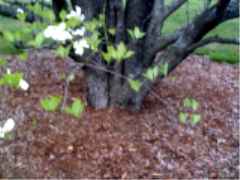 |
GRAFTING...PERPETUATING
NATURE'S MIRACLES
Pink Dogwood turning white (left & right) |
 |
 |
Root stock of what was once a "Mr. Lincoln Hybrid Tea Rose." (left) |  |
 |
GRAFTING...PERPETUATING
NATURE'S MIRACLES
Pink Dogwood turning white (left & right) |
 |
 |
Root stock of what was once a "Mr. Lincoln Hybrid Tea Rose." (left) |  |
Two parents with brown eyes can have a child with blue eyes, the brown eyes being the dominant gene and the blue eyes being the recessive gene. Plants can also produce offspring very different from their parentage. Plant breeders spend lifetimes cross pollinating flora to find new and different varieties. Colorado Blue Spruce (Picea pungens glauca) will produce a "shiner" seedling about 10% of the time. A "shiner" is a blue spruce with an especially blue needle which holds true to its color throughout the growing season compared to its 9 siblings who may start out blue, but quickly turn green. In order to obtain a Blue Spruce which you know will be truly blue, you will need to purchase a "grafted" plant. Grafting involves uniting the tissue of (scion or "cutting") of the desired plant with the root stock of another vigorous plant. Simply put, this process is kind of like gluing one plant on top of the other.
A classic example of this would be the grafting of a Golden Delicious apple onto the roots of a crabapple. The result is a tree which bears Golden Delicious apples. Common examples of grafted plants include pink dogwoods, most hybrid tea roses, lace leaf japanese red maples, and weeping cherry trees. True parentage may also be obtained in a rooted cutting of any of these plants, but seedlings will not produce predictable results. The genes contained in a cutting are always identical to that of their parent. Kind of like cloning, which is an excepted practice in the plant world. I personally hope we don't start cloning humans - once is enough.
The root stock of a successful graft will happily support the growth of its new partner, but the genetics of the root stock are that of itself. Sometimes a "wild shoot" is produced, which will reflect the genetics of the roots. This is where a shoot forms beneath the graft level of the plant. When this happens, you should promptly prune out the wild shoot to prevent the root stock from nurturing its own. Usually the mother plant will take care of its own first. This can result in the profusion of the parent plant and the gradual decline of the grafted plant. People always want to know where they can find the "two color dogwoods" seen growing here and there. What has actually happened is that a wild shoot of white dogwood roots has been allowed to grow on a pink dogwood tree. Eventually the pink dogwood will turn entirely white, though this will take years. The transition period does render an interesting and attractive plant which is quite a conversation piece.
The two above photos are of a pink dogwood turning white, and a "Mister Lincoln Hybrid Tea" rose in which the grafted "Mr. Lincoln" portion has completely died, giving way to the unknown root stock. This particular "Mr. Lincoln" rose was planted in front of our store in 1986 and neglected...shame,shame! The result has been a climbing rose which only blooms once in the spring. The rose is one hugh show of literally hundreds of crimson blooms. Customers always want to know what this plant is and where they can buy one. It could be a "Paul's Early Blush" or it could be anything. Who knows? Maybe we should make cuttings and call it the "Roxbury Rambler". In any case, the plant is a mistake which has brought us all much joy.
Andy Lynn